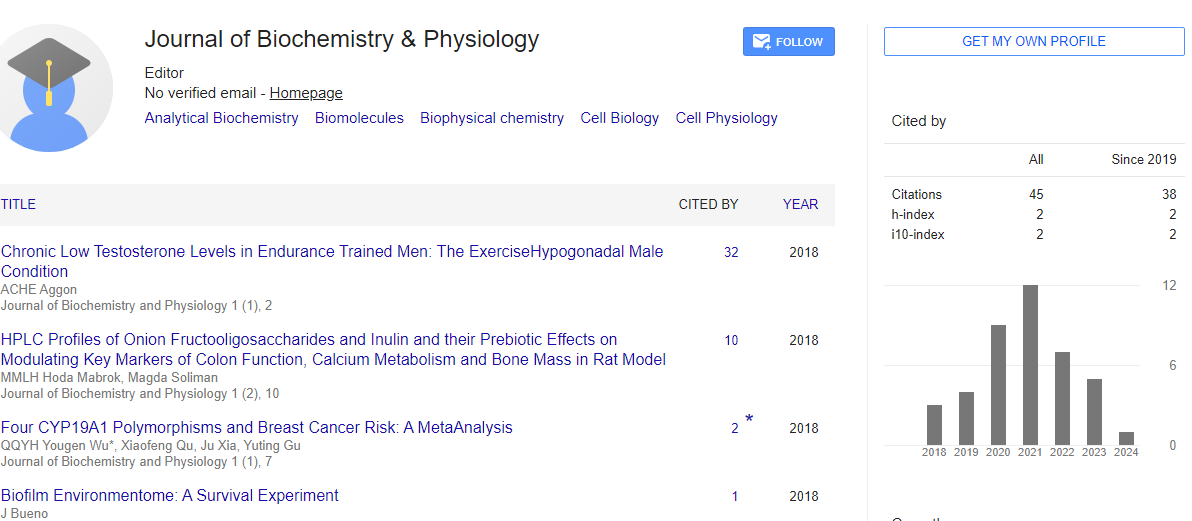Opinion Article, J Biochem Physiol Vol: 7 Issue: 1
Cellular Metabolism: Energy Production, Nutrient Utilization, and Metabolic Pathways
Zenzhu Qi*
1Department of Basic Medical Sciences, Navamindradhiraj University, Dusit, Bangkok, Thailand
*Corresponding Author: Zenzhu Qi,
Department of Basic Medical Sciences,
Navamindradhiraj University, Dusit, Bangkok, Thailand
E-mail: qizen@zhu.th
Received date: 19 February, 2024, Manuscript No. JBPY-24-134952;
Editor assigned date: 21 February, 2024, PreQC No. JBPY-24-134952 (PQ);
Reviewed date: 11 March, 2024, QC No. JBPY-24-134952;
Revised date: 20 March, 2024, Manuscript No. JBPY-24-134952 (R);
Published date: 29 March, 2024, DOI: 10.4172/jbpy.1000155.
Citation: Qi Z (2024) Cellular Metabolism: Energy Production, Nutrient Utilization, and Metabolic Pathways. J Biochem Physiol 7:1.
Description
Cellular metabolism is a complex network of biochemical reactions that governs the production of energy and the synthesis of biomolecules essential for cell survival and function. This article explores the intricacies of cellular metabolism, focusing on energy production, nutrient utilization, and the interconnected metabolic pathways that sustain cellular activities.
At the core of cellular metabolism lies the production of Adenosine Triphosphate (ATP), the universal currency of cellular energy. The primary pathways for ATP synthesis are glycolysis, the citric acid cycle (Krebs cycle), and oxidative phosphorylation. In glycolysis, glucose is oxidized to pyruvate, generating ATP and NADH. Pyruvate enters the mitochondria, where it undergoes further oxidation in the citric acid cycle, producing more NADH and FADH2. The electrons carried by NADH and FADH2 are then transferred to the Electron Transport Chain (ETC), where they drive the synthesis of ATP via oxidative phosphorylation.
Cells utilize a variety of nutrients, including carbohydrates, lipids, and proteins, as sources of energy and building blocks for cellular components. Carbohydrates are readily metabolized through glycolysis and oxidative phosphorylation to produce ATP. Lipids, in the form of fatty acids, are broken down through beta-oxidation to generate acetyl-CoA, which enters the citric acid cycle. Additionally, lipids serve as important energy reserves, stored in the form of triglycerides in adipose tissue. Proteins can also be catabolized to provide energy, although they are primarily used for cellular structure and function.
Cellular metabolism is a highly interconnected network of pathways that interconvert various metabolites to meet the cell's energy and biosynthetic needs. The integration of metabolic pathways allows cells to adapt to changing nutrient availability and energy demands. For example, the pentose phosphate pathway generates NADPH, a reducing equivalent required for biosynthetic reactions and antioxidant defense. The gluconeogenesis pathway synthesizes glucose from non-carbohydrate precursors, such as lactate, glycerol, and amino acids, to maintain blood glucose levels during fasting or starvation.
Cellular metabolism is tightly regulated to ensure energy homeostasis and metabolic flexibility in response to physiological cues. Key regulatory mechanisms include allosteric regulation, enzyme regulation by covalent modification (e.g., phosphorylation), and hormonal regulation mediated by signaling pathways such as insulin signaling. For example, insulin stimulates glucose uptake and glycolysis in response to elevated blood glucose levels, while glucagon promotes gluconeogenesis and glycogenolysis during fasting to maintain blood glucose levels.
Dysregulation of cellular metabolism is associated with a wide range of human diseases, including obesity, diabetes, cancer, and metabolic disorders. In obesity and type 2 diabetes, impaired insulin signaling leads to insulin resistance, resulting in dysregulated glucose and lipid metabolism. Cancer cells exhibit altered metabolism, characterized by increased glycolysis (the Warburg effect) and glutamine dependency, to support their rapid growth and proliferation. Understanding the metabolic alterations in disease states offers insights into potential therapeutic targets for intervention.
Advances in metabolic research have led to the identification of novel metabolic pathways, regulatory mechanisms, and therapeutic targets. Metabolomics, a comprehensive analysis of metabolites in biological samples, has emerged as a powerful tool for studying cellular metabolism and disease biomarkers. Targeting metabolic pathways, such as glycolysis, fatty acid metabolism, and amino acid metabolism, holds promise for the development of precision medicine approaches for metabolic diseases and cancer.
Conclusion
Cellular metabolism is a dynamic and tightly regulated process that governs energy production, nutrient utilization, and biosynthesis in cells. The interconnected metabolic pathways ensure the efficient conversion of nutrients into ATP and biomolecules essential for cell function and survival. Dysregulation of metabolism is implicated in various diseases, highlighting the importance of understanding metabolic pathways in health and disease. Continued research in cellular metabolism offers opportunities for therapeutic intervention and the development of personalized medicine approaches.
 Spanish
Spanish  Chinese
Chinese  Russian
Russian  German
German  French
French  Japanese
Japanese  Portuguese
Portuguese  Hindi
Hindi 